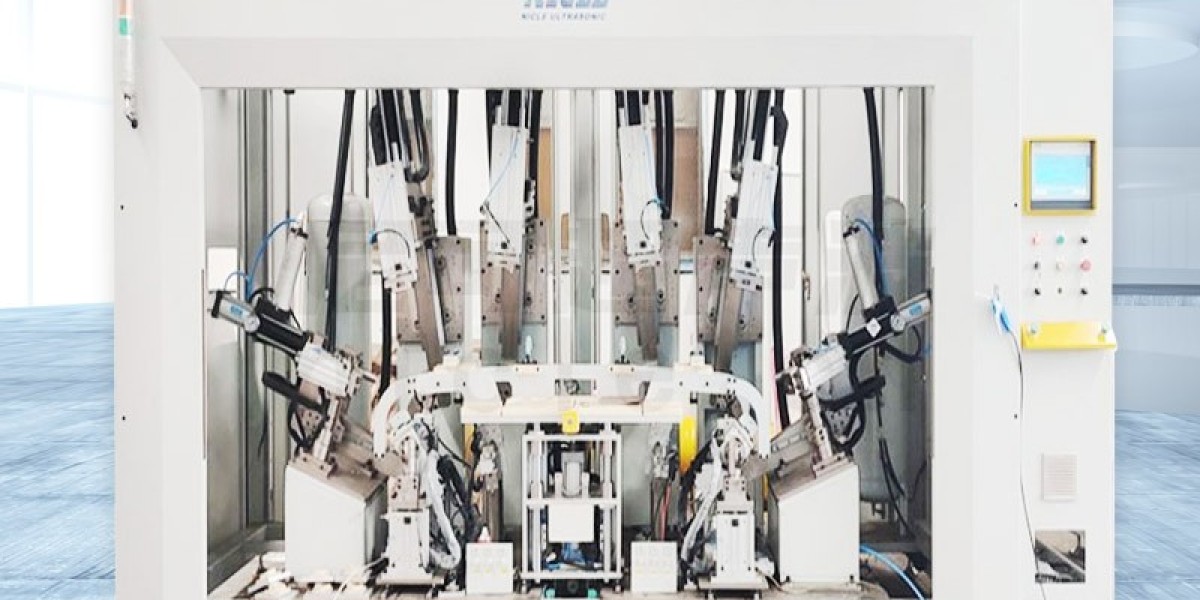How Ultrasonic Welding Works
Ultrasonic welding utilises high-frequency sound waves to create frictional heat at the joint interface of two materials. This process forms a strong bond without requiring external adhesives or excessive heat, making it an energy-efficient alternative to traditional welding methods such as hot plate or resistance welding.
Factors Affecting Energy Efficiency
Power Consumption
Ultrasonic plastic welding systems typically operate in the 15 kHz – 40 kHz frequency range.
Higher frequency systems (e.g., 30–40 kHz) generally consume less power but are suitable for thinner or delicate materials.
Optimising power settings ensures minimal energy waste while maintaining strong welds.
Cycle Time Reduction
Ultrasonic welding is known for its fast cycle times—often in the range of milliseconds to a few seconds.
Shorter cycle times lead to lower overall energy usage per weld, making the process more efficient than traditional heat-based methods.
Automation and Smart Controls
Modern ultrasonic plastic welding systems integrate automated features such as real-time monitoring, adaptive power control, and energy recovery systems.
Smart energy management systems ensure power is only used when needed, avoiding unnecessary energy consumption.
Sustainability Benefits of Ultrasonic Welding
Reduced Material Waste
Unlike traditional welding techniques, ultrasonic welding does not require additional fasteners, glues, or solvents, reducing chemical waste and material usage.
The process produces minimal flash or scrap, leading to lower material costs and reduced landfill waste.
Lower Carbon Footprint
Energy-efficient welding systems consume significantly less electricity than conventional heat-based welding.
A reduction in energy demand directly contributes to lower CO₂ emissions, supporting manufacturers’ sustainability goals.
Non-Toxic and Safe Process
Since ultrasonic welding does not involve open flames, toxic adhesives, or chemical by-products, it enhances workplace safety and air quality.
The elimination of volatile organic compounds (VOCs) reduces hazardous emissions in production environments.
Extended Product Lifespan
High-quality ultrasonic welds provide stronger, more durable joints, reducing the likelihood of early product failure.
Longer-lasting products contribute to less waste and lower resource consumption over time.
Optimising Ultrasonic Welding Systems for Maximum Efficiency
Choosing the Right Frequency and Power Settings
Lower frequencies (15–20 kHz) are suitable for thicker or tougher materials but may consume more power.
Higher frequencies (30–40 kHz) work best for thin or delicate materials, providing energy savings.
Power settings should be optimised for each material to prevent excessive energy use while ensuring strong welds.
Implementing Smart Energy Management Systems
Automated shutoff features prevent energy waste when the machine is idle.
Real-time monitoring allows operators to adjust energy usage based on material properties and production demands.
Variable frequency drives (VFDs) can dynamically adjust power based on the load, reducing energy spikes.
Using Sustainable and Recyclable Materials
Choosing biodegradable plastics or recycled thermoplastics enhances the eco-friendliness of ultrasonic welding.
Ensuring that welded materials are easy to separate for recycling helps reduce electronic and plastic waste.
Enhancing Equipment Efficiency
Regular maintenance and calibration improve energy efficiency by preventing power loss due to misalignment or worn-out parts.
Upgrading to energy-efficient generators and transducers reduces overall power consumption.
Applications of Energy-Efficient Ultrasonic Welding
Automotive Industry
Used for lightweight plastic welding in vehicle interiors, dashboards, and battery enclosures.
Helps reduce the overall weight of vehicles, improving fuel efficiency and lowering emissions.
Medical Device Manufacturing
Used for assembling sterile medical instruments and disposable healthcare products without toxic adhesives.
Energy-efficient ultrasonic welding ensures high precision while minimising material waste.
Consumer Electronics
Enables the production of small, intricate electronic components such as sensors, housings, and circuit boards.
Reduces the need for excess wiring and additional fasteners, making products more sustainable.
Packaging Industry
Creates airtight seals for food and pharmaceutical packaging without additional adhesives or heat-sealing elements.
Reduces energy consumption compared to traditional heat-sealing processes.
Challenges and Future Developments
Challenges
Initial Equipment Costs – High-efficiency ultrasonic welding systems may require a significant upfront investment.
Material Compatibility – Not all materials are easily weldable using ultrasonic technology, requiring advanced research into eco-friendly polymers.
Process Optimisation – Achieving consistent weld quality while minimising energy use requires precise calibration and expertise.
Future Trends
AI-Powered Welding Systems – Machine learning algorithms can optimise power usage and adjust settings automatically for maximum efficiency.
Renewable Energy Integration – Factories may power ultrasonic welding systems using solar, wind, or other renewable sources to further reduce carbon footprints.
Advanced Biodegradable Materials – New sustainable plastics will improve the environmental impact of ultrasonic welding.
Conclusion
Energy efficiency and sustainability are becoming key priorities in ultrasonic welding. By optimising power consumption, minimising waste, and integrating smart technology, manufacturers can significantly reduce their environmental impact while maintaining high production efficiency.
As industries continue to innovate, ultrasonic welding systems will play a vital role in sustainable manufacturing. Investing in energy-efficient welding processes not only benefits the environment but also lowers operational costs and enhances product quality.








